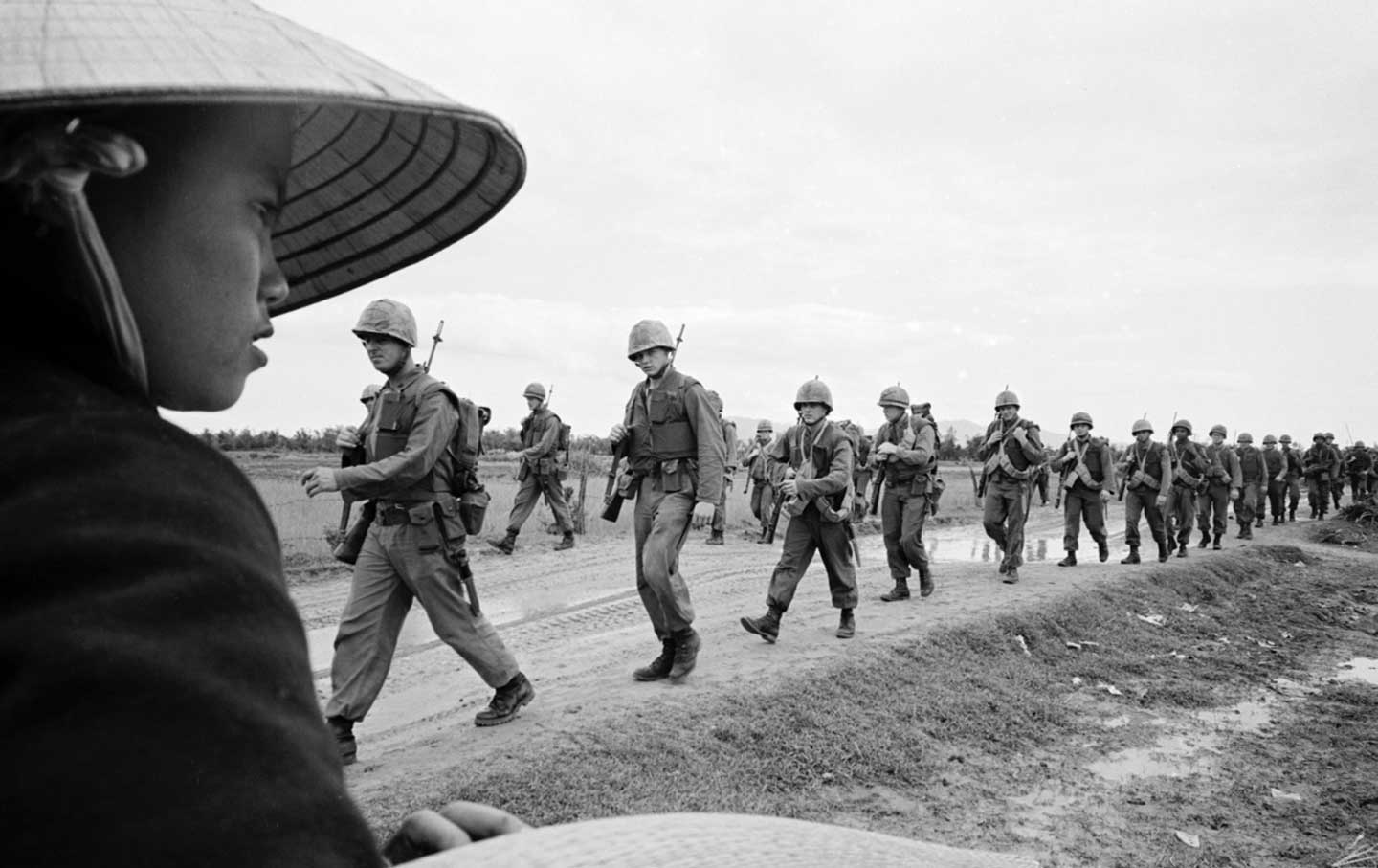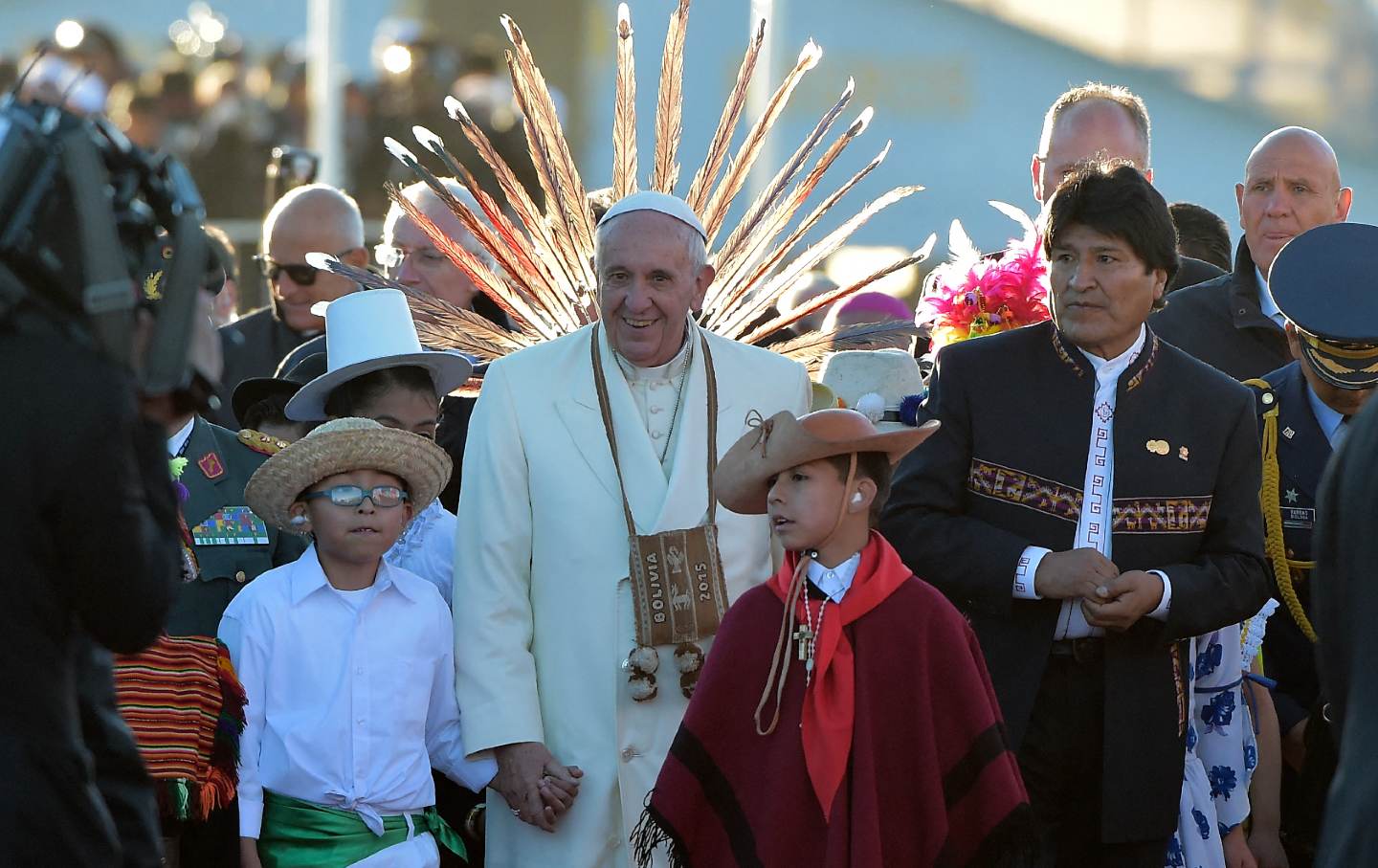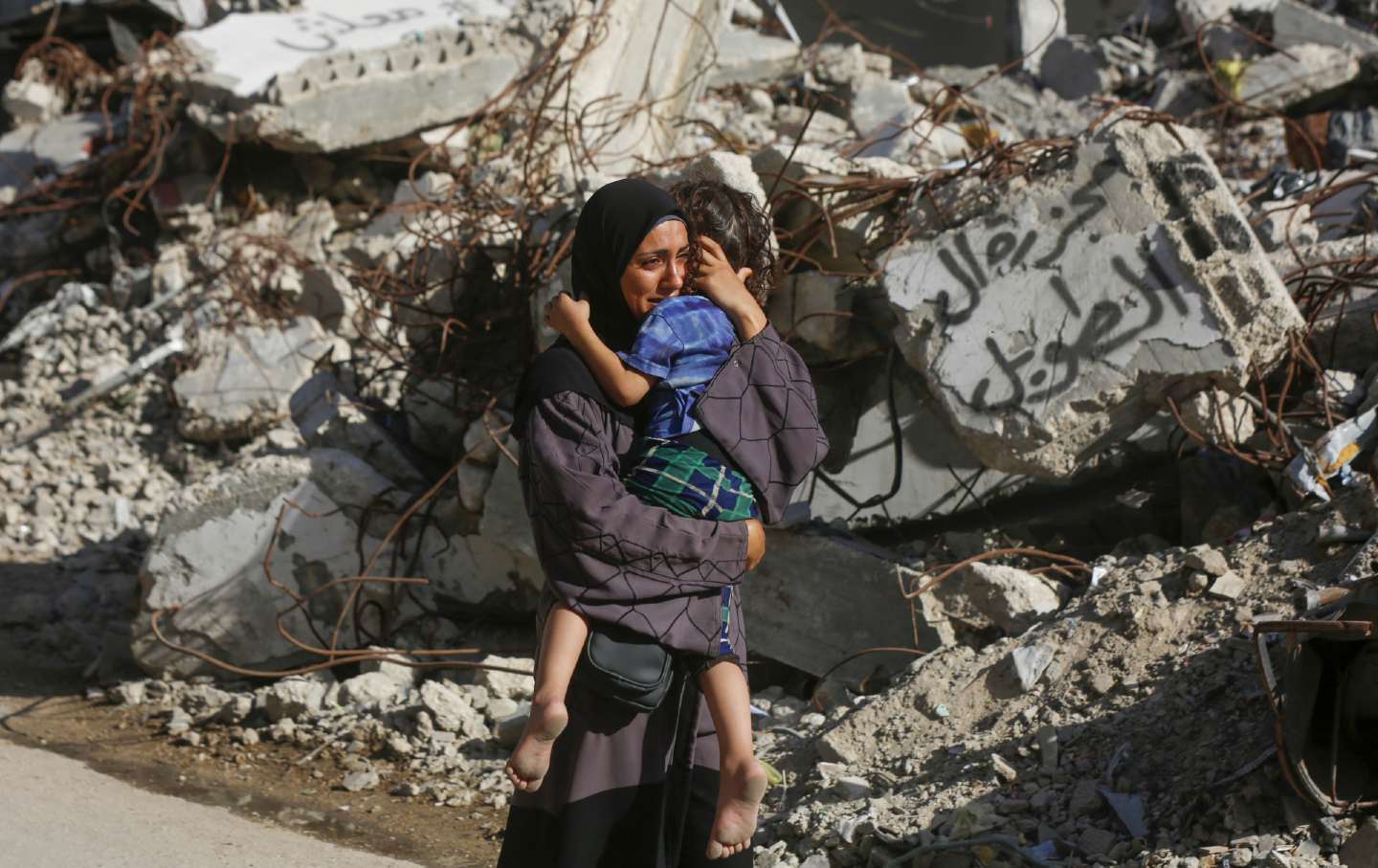How Israel Is Borrowing From the US Playbook in Vietnam
Justifying civilian casualties has a long history.

US Marines marching in Da Nang, Vietnam, 1965.
(AP Photo / Courtesy of PBS)Since the start of Benjamin Netanyahu government’s war on Gaza four weeks ago, Israeli officials and Western proponents of the war have turned to a variety of arguments to justify the extreme civilian death toll that’s been suffered.
“Hamas, the genocidal terrorist organization, is responsible for everything that happens in Gaza,” stated the IDF over an image of a bombed neighborhood in the territory, arguing that Hamas indoctrinates Palestinian kids, fires rockets from civilian neighborhoods, and embeds itself within civilian areas, making them “legitimate military targets.”
“This is the tragedy of war, Wolf,” IDF spokesperson Lt. Col. Richard Hecht told CNN’s Wolf Blitzer when questioned about Israel’s October 31 bombing of the Jabalia refugee camp. “We’ve been saying for days, move south, civilians who are not involved with Hamas, please move south…. About the civilians there, we’ve been doing everything we can to minimize. I’ll say it again, sadly they are hiding themselves within the civilian population.”
“We’re doing everything possible to reduce and prevent civilian casualties in Gaza,” former Israeli Prime Minister Naftali Bennett recently said. “At the end of the day Hamas, cynically, is telling citizens they can’t move here, they can’t move there, using citizens, Hamas citizens, I mean Gaza citizens, as human shields. So in that sense, ultimately, Hamas is responsible for any deaths of Gazan civilians.”
“This is war, this is combat,” US National Security Council spokesperson John Kirby told reporters when asked about civilian casualties. “It is bloody, it is ugly, and it’s gonna be messy. And innocent civilians are going to be hurt going forward. I wish I could tell you something different.”
The Israeli ambassador to the United States had dismissed the mounting death toll in Gaza, insisting that “neither you nor I know how many of them are armed terrorists and how many of them are civilians,” while the Israeli government has repeatedly claimed Hamas is hiding a network of tunnels and even a military base under hospitals it has attacked.
If these arguments sound familiar, it’s because they’re the same ones Israeli officials have used for years to justify disproportionate civilian casualties from the country’s periodic bombing of the Gaza Strip. But they also have a much older pedigree: Virtually all of these talking points were used decades ago by US and South Vietnamese officials to justify the horrific civilian death toll caused by the US war in Vietnam—a war that is viewed overwhelmingly negatively by Americans today, and whose brutal bombing campaigns few would now justify.
Yet that’s exactly what US officials and commentators did one year into Operation Rolling Thunder, President Lyndon Johnson’s three-year-long bombing campaign that saw 864,000 tons of bombs and missiles dropped on the country and killed 21,000 civilians. Christmas 1966 saw the publication of the first dispatch from North Vietnam by New York Times reporter Harrison Salisbury, who had become the first American journalist to report from Hanoi, and through firsthand accounts disproved the administration’s assurances that the US military was targeting only “concrete and steel, not human life.”
US officials’ responses might give us a bout of déjà vu today.
“All possible care is taken to avoid civilian casualties,” read a Pentagon statement responding to Salisbury’s report. But, it continued, “it is impossible to avoid all damage to civilian areas, especially when the North Vietnamese deliberately emplace their air defense sites, their dispersed [petroleum] sites, their radar and other military facilites in populated areas and, indeed, sometimes on the roofs of government buildings.” US officials insisted that civilian areas around the towns of Nam Định and Phủ Lý, whose destruction Salisbury reported on, were “loaded” with antiaircraft gun batteries and missile firing positions.
A variety of US officials joined in. “Is there any place in the world where there are not civilians? I know US operations are aimed exclusively at military targets, but unfortunately there are some civilians around these targets,” said former President Dwight. D. Eisenhower. “You can’t have a war without killing people,” said Senator Bourke B. Hickenlooper (R-Iowa).
The administration spoke out of both sides of its mouth: A State Department spokesperson insisted that damage to civilian areas was purely accidental, while anonymous officials told the Los Angeles Times that, in fact, they were no accident, because the targets were really military ones. As homegrown outrage at Johnson’s bombing campaign grew, another State Department press officer later insisted that “the policy on targets remains as it has been—they are military or military associated targets,” but noted that civilians might still die “despite all possible precautions.”
Popular
“swipe left below to view more authors”Swipe →Even before Salisbury’s reporting, the war’s supporters had excused US troops’ killing of Vietnamese civilians, often by pointing to the Viet Cong’s very real practice of blending in among them. Pointing to two controversial incidents at the time where US Marines had killed five civilians, including three kids, and set fire to 51 houses, Chicago Daily News reporter and veteran war correspondent in Asia Keyes Beech had assured Americans in a widely reprinted August 1965 column that
Marines do not especially enjoy shooting women and children. Nor do they get a kick out of burning down houses. But this is that kind of war. War is never pretty but some wars are uglier than others…. The problem, briefly, is this: how to separate the enemy form the innocent in a guerrilla war that knows no front.
Beech maintained that “many Vietnamese women are dedicated communists and can handle a gun just as well as their husbands, if not better,” and that “the same is often true of their children.” And a Vietnamese house wasn’t always a home, he declared, but “a fortified position” that may lead to a network of Viet Cong tunnels and could prove deadly for any soldier daring to peek in. “Nine times out of 10 you never know who the VC is until he shoots at you, and then it’s often too late,” he quoted one captain telling him.
Ironically, in the process of defending the Marines’ conduct to Beech, one officer obliterated the US military’s justification for its air strikes, which often involved pointing to all the Viet Cong it had supposedly killed. “I wonder how those high-flying jet pilots tell a Viet Cong from another Vietnamese,” the officer said. “And isn’t a 500-pound bomb likely to kill more innocent people than a Marine rifle?”
Gen. William Westmoreland, commander of the US forces in Vietnam, deemed accidental civilian deaths “a great problem” in 1966, but similarly charged that the war was “designed by the insurgents and the aggressors to be fought among the people,” suggesting that the Viet Cong were ultimately responsible for their deaths. Westmoreland had established rules that were supposedly meant to limit civilian casualties: Residents of a village suspected of hiding Viet Cong first had to be warned via leaflet or loudspeaker planes before an air strike was carried out, unless it was under total communist control, in which case it was a “specified strike zone”—later known as a “free-fire zone”—and US forces could bomb whatever they wanted. In one such case, US forces killed 20 civilians and wounded 32.
“Some of this is just human failure, bad judgment,” one high-ranking military figure commented. Much like Israeli leaflets telling Gazans to evacuate today, these warnings were a thin justification for what followed, as when troops spent hours telling civilians via loudspeaker to leave a communist-controlled area in one 1968 assault, but “for some reason they didn’t leave before US forces attacked with napalm,” leaving 17 dead, according to the Associated Press.
Vietnam-era US officials even made use of an allegation that has become ubiquitous in the current war: enemy forces using innocent people as human shields. In one January 1967 incident, South Vietnamese forces shelled a village, killing 10 children and wounding 16, only for a US spokesperson to claim—falsely, it soon turned out—the Viet Cong had “herded” civilians in front of them as they advanced. “These civilian casualties are very regrettable and are directly attributable to the callous use of civilians by the Viet Cong in military operations,” the spokesperson said. Such claims abounded throughout the war.
In reality, as journalist Nick Turse uncovered decades later when he went digging through archives and interviewing ex-GIs, all of these US statements papered over a far more brutal truth: That, far from being accidents or the tragic ugliness of war, the high number of Vietnamese civilian deaths resulted from deliberate policy set at the top and enacted by US troops on the ground, rooted in officials’ emphasis on “body count” and a view of Vietnamese as “animals,” all of whom, even women and children, were potential threats. Even the infamous My Lai massacre was at first publicized by the US government as a grand military triumph over enemy fighters.
The war waged by the US government in Vietnam today is widely viewed as a shameful and regrettable episode in the nation’s history, and few would defend it or its attendant bombing campaigns. It’s hard to imagine anyone today taking seriously the claims of the Johnson and Richard Nixon administrations and its defenders that they were purely attacking military targets, or view their protestations that the Viet Cong’s intermingling with civilian populations as a reasonable justification for the civilian casualties that ensued—let alone claims that the brutal nature of war made such human carnage inevitable.
Yet all of these arguments are now being made by Israeli and US officials and commentators to justify a staggering level of civilian death in Gaza—and are seemingly largely being accepted by those in positions of influence, who would never excuse US actions in Vietnam this same way. As Israeli officials and those defending them recycle these Vietnam War–era talking points for a bombing campaign that in a month has killed half the civilians Operation Rolling Thunder killed over three years, it’s fair to ask whether we’ve learned anything from history.
Hold the powerful to account by supporting The Nation
The chaos and cruelty of the Trump administration reaches new lows each week.
Trump’s catastrophic “Liberation Day” has wreaked havoc on the world economy and set up yet another constitutional crisis at home. Plainclothes officers continue to abduct university students off the streets. So-called “enemy aliens” are flown abroad to a mega prison against the orders of the courts. And Signalgate promises to be the first of many incompetence scandals that expose the brutal violence at the core of the American empire.
At a time when elite universities, powerful law firms, and influential media outlets are capitulating to Trump’s intimidation, The Nation is more determined than ever before to hold the powerful to account.
In just the last month, we’ve published reporting on how Trump outsources his mass deportation agenda to other countries, exposed the administration’s appeal to obscure laws to carry out its repressive agenda, and amplified the voices of brave student activists targeted by universities.
We also continue to tell the stories of those who fight back against Trump and Musk, whether on the streets in growing protest movements, in town halls across the country, or in critical state elections—like Wisconsin’s recent state Supreme Court race—that provide a model for resisting Trumpism and prove that Musk can’t buy our democracy.
This is the journalism that matters in 2025. But we can’t do this without you. As a reader-supported publication, we rely on the support of generous donors. Please, help make our essential independent journalism possible with a donation today.
In solidarity,
The Editors
The Nation








